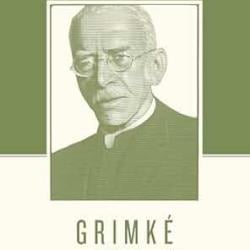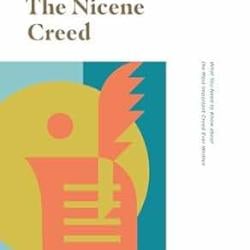Review of Retrieving Nicaea: The Development and Meaning of Trinitarian Doctrine by Khaled Anatolios
This is the second installment of Reading Patristics–a review series dedicated to books about the early church fathers. These reviews will not be exhaustive summaries, but instead are meant to pique the interest of readers to pursue reading in this area of study and a guide to good books in the field. Previous installments: Classical Christian Doctrine.
The recently published Retrieving Nicaea is part of a long tradition of literature reviving interest in the Trinity. It is also representative of revisionary scholarship contributing to new debates about Nicene theology. Retrieving Nicaea can be read for the sake of stretching the mind and challenging common perspectives on the theological controversies during the years before and after the Nicene Council. I cannot, however, recommend it wholeheartedly, for reasons I will explain below.
When we hear the words “Nicene Council,” Christians quickly think of the “Arian controversy” and the battles waged for orthodoxy: God is of one essence (homoosious) in three persons (hypostaseis). Arius and his followers offered a different framework: Jesus Christ is begotten, hence there was a time when the Son did not exist. Jesus is in fact the firstborn of creation, but is not eternal. The Nicene Council successfully rejected Arius’s ideas as heretical. In Retrieving Nicaea, Khaled Anatolios argues for a different take on Nicene theology.
Anatolios views this mainstream telling of the Nicene Council as shallow and erroneously fixated on innovative terminology, making the theological controversy merely one of philosophical significance with little relevance to the piety of the theologians debating the Trinity. Rather, “the central issue motivating the development of fourth-century Trinitarian thought was the reintegration of the principle of divine primacy with that of the primacy of Christ” (90). These patristic theologians were deeply doxological in their concern to maintain Christ’s status as an object of worship, while also recognizing a difference between the Father and the Son.
Retrieving Nicaea presents a historical perspective that shows not merely the dissimilarities between the Arians and Nicene theologians, but also their similarities. Now, centuries later, we see them in stark contrast, whereas at the time, these interlocutors “were all interacting within a common narrative, a common set of Christian experiences; they deployed different features of this common narrative and experience in order to construct various ‘coherences’ of Christian life. At the center of these various coherences was the question of how to integrate a fitting conception of absolute divine primacy with the lordship of Christ” (58).
Anatolios begins his investigation with a list of elements constructing a common fundamental theology (36), a common doctrinal confession (36-38) and common negative boundaries (38). Readers are immediately struck by the wide, overlapping propositions both sides took. They agreed on Scriptural canonicity; apostolic authority in interpretation; applying reason to faith; the Trinity as object of Christian faith and worship; creation ex nihilo; the primacy and lordship of Christ; and the heretical nature of Manichaeism, gnosticism, Samosatene theology of adoption, and Sabellian modalism.
With all this commonality, what sparked the controversy? Anatolios argues for three breaks in pre-Nicene experience: 1) the Creator-creation distinction increasingly seeped into philosophical and theological discourse at all levels, 2) “the existence and soteriological significance of Jesus’s human soul” (39-40), and 3) the wave of systematization overtaking philosophical schools, requiring a similar response from Christians.
Anatolios frames the “Arian controversy” as disagreement between two Trinitarian schools of thought—those holding to the unity of will and those holding to the unity of being. His phraseology emphasizes the point that both sides were concerned with “unity” of the Godhead, but differed on the nature of this unity. In his own words, “some affirmed the primacy of Christ by associating him with the being of the Father, thereby christologically reconstructing the category of absolute transcendence. Others affirmed the primacy of Christ by associating him with the will of the Unbegotten, thereby reasserting the recently clarified insistence on the sovereign freedom of the biblical God and his distinction from all that is caused” (41-42).
Among the Trinitarian theologians of unity of will we find Arius as chief progenitor, whose theology is revised by Asterius, Eusebius of Caesarea, and Eunomius of Cyzicus. Among those supporting unity of being are Alexander of Alexandria (Athanasius’s predecessor as bishop), Marcellus of Ancyra, and Apollinaris of Laodicea. If we were to oversimplify things and label the unity of will proponents as “Arius’s party,” and unity of being theologians as “orthodoxy-defenders,” we will be surprised by some of the names. Eusebius of Caesarea is judged positively by history, yet he is in the same camp as Arius, while Apollinaris is condemned as a heretic for claiming the divine logos took the place of the rational human soul of Jesus.
Each school of Trinitarian thought is described through the way each of these theologians built on and revised prior theologians. The interplay makes for fascinating reading. But more than half of the book is dedicated to discussing the Trinitarian doctrine of three theologians of unity of being–Athansius of Alexandria, Gregory of Nyssa, and Augustine of Hippo. Each gets a whole chapter. These chapters are also the most tedious as Anatolios explains and provides commentary on each of these thinkers’ key writings on the Trinity.
Anatolios’ goal is to “retrieve” Nicaea, by which he means have a correct understanding of the theological discussions surrounding the Nicene Council in order to inculcate its lessons in contemporary Christian faith and practice. His concluding chapter systematizes Nicene Trinitarian theology and applies it to various themes of Christian doctrine and worship. For example, the Trinitarian implications of baptism (in the name of the Father, the Son, and the Holy Spirit) and eucharistic communion (“self-offering of the Incarnate Son to the Father in the Spirit and in the mutual glorification of the Father and the Son by the Spirit” (285)). Or in regards to creation, matter (or human corporality) is not antithetical to “divine goodness,” but rather is part of the creation that God called “good”—such that Christ might himself be the union of human and divine
Perhaps the most interesting “retrieval” for evangelicals will be in terms of soteriology. Anatolios bemoans the fact that soteriology “has become a prevalent form of theological piety to reduce the “real meaning” of any theological system to its soteriology” (290). Hence, it is ironic that I am drawing attention to this section on soteriology. Anatolios, however, will find many sympathizers among Reformed-minded readers.
One of the major debating points was where to locate the pro nobis (“for us”) in the divine-human nexus of Christ. Those who advocated a unity of will and there a subordinate status to Christ’s divinity found the pro nobis at the beginning of Christ’s being, since he is the first of creation and thereby an appropriate mediator. On the other hand, theologians of unity of being (Nicene theology) located the pro nobis in the incarnation. Since “Nicene theology tended to be emphatic about restricting the christological pro nobis to Christ’s humanity,” “to properly construe the primacy of Christ is not simply to know his benefits ‘for us’ but to know his glory, for whose sake creation itself exists (cf. Col. 1:16). Retrieving the Nicene account of the primacy of Christ involves extending the range of soteriology into doxology” (290).
To sum it all up, “[t]he task of Trinitarian theology is not to claim fully adequate expressions or analyses of divine being but to clarify the rules generated by God’s self-revelation that enable us to successfully refer our being and activity, knowingly and lovingly, to Father, Son, and Holy Spirit” (292). This should resonate with the heart of any Christian who takes theology seriously. The motive for doing theology is oriented toward doxology. We know deeply to love deeply.
Anatolios brings to the fore strands of Trinitarian theology during the patristic era that re-imagine these great theologians. Retrieving Nicaea succeeds in challenging readers to think not just historically, but think about the intersection of theology and worship and practice. But it ultimately fails in its delivery. Trinitarian theology is back in vogue, but this renewed interest in Trinitarian doctrine among scholars has remained ensconced behind the walls of the academy. Retrieving Nicaea is an example of why this is so. Paragraphs span whole pages, making Anatolios’s arguments hard to follow. These structural issues are sadly complemented by dense prose that demonstrates a lack of concern for comprehensibility.
I understand that this is an academic work, but I found it ironic that a book trying to retrieve Nicene theology for the modern church, a theology already inaccessible to most due to its historic nature, largely leaves this theology in obscurity due to its presentation. Perhaps a second edition may be released in the future. If so, I recommend heavy editing.
By no means does this critique of prose and style take away from the substantive contribution Anatolios makes to our understanding of patristic Trinitarian theology, but it will limit the influence it has. While not as academic or ambitious in scope, Fred Sanders’s The Deep Things of God: How the Trinity Changes Everything and Michael Reeves’s Delighting in the Trinity: An Introduction to the Christian Faith offer models of engaging with the desired audience: worshippers of the Triune God.
[Disclosure: I received this a free review copy of this book from Baker Academic, but was not required to write a positive review.]












